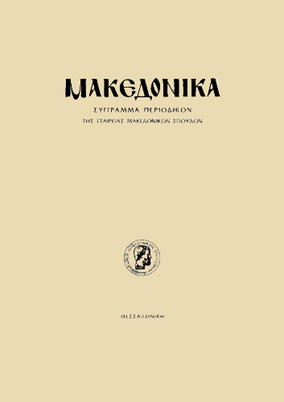Οι παλαιότερες φάσεις τοιχογράφησης της Παναγίας συνοικίας Μουζεβίκη στην Καστοριά και η εξέλιξη της τοπικής εικονογραφικής παράδοσης
Part of : Μακεδονικά ; Vol.31, 1998, pages 135-170
Issue:
Pages:
135-170
Parallel Title:
The Earliest Phases of the Frescoes in the Church of the Panagia in Mouzeviki, Kastoria, and the Development of the Local Iconographical Tradition
Section Title:
Articles
Abstract:
Amidst a number of Byzantine and post-Byzantine churches in the Mouzeviki quarter of the Doltso district of Kastoria stands the Church of the Mother of God, now dedicated to St Menas, patron saint of Kastoria. Eighteenth-century sources refer to the church as the ‘Monastery of the Theotokos Mouzevikou’. The only building still standing today is the very elongated church (22.42x6.85 m) with a narthex, decorated with frescoes from four different periods. The only phase specified by a founder’s inscription is the 1654 phase, which the writer has already investigated. However, a close inspection of the sanctuary and a small area outside it reveals two more layers of older frescowork. The earliest paintings are in the apse and represent the Panagia Vla- chernitissa and the Melismos with the co-officiating prelates. They share close iconographical similarities with the south chapel in Agioi Konstantinos and Eleni in Ohrid and display the same style as a number of monuments dated to the late 14th to mid-15th century in Kastoria, Prespa, and the Ohrid area, and this attests the artistic environment to which they belong. The micrographie tendencies, the expressive, anticlassical approach, the deep moulding with white highlights, the lively, fleeting glance, together with the typology, are also seen in the frescoes in the south chapel in Agioi Konstantinos and Eleni at Ohrid (c. 1400), the Church of the Analipsi at Lescovac (1451/2), and the Chapel of the Apostles in Agios Nikolaos at Bolnica (c. 1467). Consequently, a dating in the second third of the 15th century for our monument seems plausible and also supplies the missing link in the art of Kastoria between the frescoes in Agios Andreas tou Rousouli (1430) and those in Agios Nikolaos tis monachis Eupraxias (1485/6). Most of the sanctuary is covered with frescoes that are later than those in the apse, and this is supported by the plaster. From top to bottom and east to west, the representations are: the Annunciation, the Communion of the Apostles, the Nativity, the Lament, and the Descent into Hell. These are followed by a number of saints in medallions, the co-officiating prelates below these, and then the Melismos of the fifth century. The Gospel themes follow the realistic iconography that developed in north-western Macedonia in the 15th century, and we may thus recognise the influence of the so-called ‘Kastoria atelier’ in the Annunciation and the Lament, similarities shared with the Nativity in Agioi Anargyroi at Servia, and anticlassical motifs in the Descent into Hell.In the zone of medallions, the iconography is similar to that in Agioi Apostoloi tou Tzotza. In particular, the local saints Germanos, Achillios of Prespa, and Clement of Ohrid are notable in that they are so rarely portrayed. This is the fifth known representation of Clement in a monument in Greece. Of the sainted prelates in the lower zone, Cyril of Alexandria stands out for the beauty of his portrait. The paintings in this phase are distinctive for their robust, regularly proportioned figures. The moulding and the chiaroscuro are soft. The rich palette carries echoes of Katelanos’s principles, and the painter also seems to be familiar with the work of Onoufrios. In conclusion, and bearing in mind the two later phases of the 17th century (which have already been studied), we may appreciate the importance of this church, which was constantly being renovated, with the greatest respect being shown to the earlier phases. The first layer may be assigned to a period when Kastoria was a mere bishopric, while the second must be dated to after it became a metropolitanate, i.e. post-1531, probably under Methodius. This period was characterised by a sharp increase in the Christian population of Kastoria and by considerable artistic activity (new monuments, renovated churches). We know for a fact that three monastery churches were functioning; one of them was the Panagia tou Mouzeviki.
Subject (LC):
Notes:
856:https://ejournals.epublishing.ekt.gr/index.php/makedonika/article/view/5679, DOI: https://doi.org/10.12681/makedonika.118
Electronic Resources:




